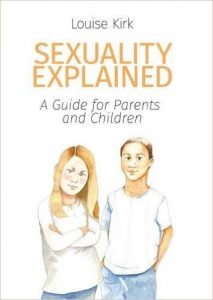Sexuality Explained: A Guide for Parents and Children
by Louise Kirk
 Louise Kirk knows what it is like to raise children through the years when their sense of sexuality is awakening. Even if the Introduction to Sexuality Explained: A Guide for Parents and Children did not mention Kirk’s husband and four children, the rest of the book makes apparent her familiarity with parent-child communication.
Louise Kirk knows what it is like to raise children through the years when their sense of sexuality is awakening. Even if the Introduction to Sexuality Explained: A Guide for Parents and Children did not mention Kirk’s husband and four children, the rest of the book makes apparent her familiarity with parent-child communication.
The heart of each chapter of Sexuality Explained is a story about a conversation between a child and a parent—Josie with her mother or Michael and his dad. The subject of sexuality comes up in the kitchen, the car, or during an afternoon of fishing, prompted by the child’s curiosity or something said at school. The circumstances and dialogue sound natural, blending seriousness and humor, interrupted by ordinary life’s intrusions like the need to get dinner on the table, shift topics when others arrive, or focus on heavy traffic.
In each conversation the parent explains some aspect of human sexuality in an age-appropriate manner. The first five chapters are principally for girls: introducing the female menstrual cycle and then reviewing it in more detail, explaining the ovulation cycle and the role of mucus, giving an overview of male fertility and the process of conception, and finally a conversation about social behavior and sexual bonding. The author suggests age levels for each chapter, beginning with chapter one between the ages of nine and eleven, through to using the fifth chapter between the ages of thirteen and fifteen. The three chapters aimed at boys are similarly arranged. The last two chapters in the book are for older children of either gender, explaining sexually transmitted diseases, the complementarity of the sexes, ramifications of contraception, and how to work naturally with fertility. Information is scientifically accurate and a lengthy set of notes at the end of the book provides supporting evidence and resources for further exploration.
The beauty of the story format is that it can be used in several ways. A parent can read each story with the child, discussing points and illustrations as they go along. Diagrams the fictional parent makes for his or her child are sure to interest real children, who will also enjoy illustrator Jessie Gillick’s amusing drawings of family scenes. Secondly, using the stories as a model for how to have intelligent and comfortable conversations with a child about biology and morality, a parent can explain any topic in his or her own words. Each chapter concludes with a list of key points and a glossary. The diagrams are reproduced at the back of the book so that a parent can use them independently of the book. Thirdly, a parent could give a child a chapter to read alone before following up with a conversation.
Sexuality Explained does not espouse any particular faith. At the same time, everything it says is in accord with Catholic teaching. The book advocates virginity until marriage and sexual self control, appreciates the “whole person, spirit, mind and body,” and values the unity of love and marriage without naming a religious moral code. The subject of contraception is deftly handled through a lunch table conversation in which adults and teens discuss facts about how artificial methods actually work, make observations about the social effects of contraception, and share correct information about natural family planning. There is no preaching, just dialogue, including some tension among the participants. Josie and Michael’s parents demonstrate non-reactive management of issues, such as a parent acknowledging and respectfully correcting inaccurate information heard at school.
This book was published in the United Kingdom as a companion resource for a character education program. It uses words and idioms (e.g., “mum,” “chipped in,” “knickers,” “chuffed”) and spellings (e.g., faeces, oestrogen) that might be unfamiliar to most Americans. U.S. parents who move past vocabulary issues will find Louise Kirk’s guide a wonderful resource as they help their children understand the beauty of sexuality.
Reviewer information
Mary Ann Paulukonis, retired from diocesan family life ministry, now devotes herself to other family, creative, and ministerial endeavors.
Disclaimer: Book reviews do not imply and are not to be used as official endorsement by the USCCB of the work or those associated with the work. Book reviews are solely intended as a resource regarding publications that might be of interest to For Your Marriage visitors.




